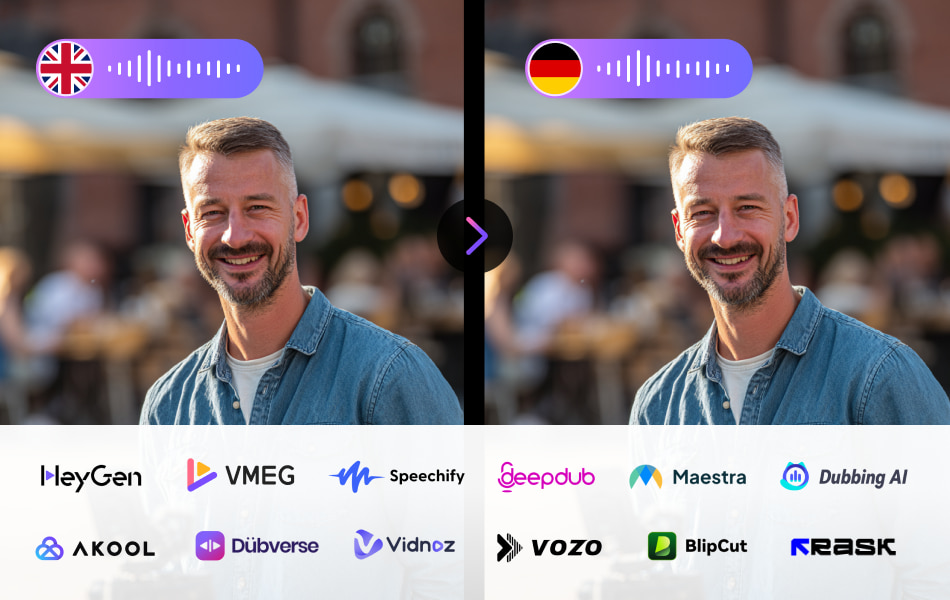
It used to take weeks of back-and-forth editing, needing a recording studio and voice actors to dub a video into another language. Today, it’s as simple as uploading a file and clicking a button. The AI in the media and entertainment market is set to grow from $14.8 billion in 2023 to nearly $100 billion by 2030, with dubbing and video translation among the fastest-rising applications according to the MarketsandMarkets Report.
For creators, educators, and marketing teams, today’s tools can: translate videos into dozens of languages instantly, clone voices while keeping tone and emotion intact, auto lip-sync so the dubbing matches the speaker naturally, and export polished, ready-to-publish videos without the studio costs.
The cost advantage is just as striking. Traditional dubbing averages $75–$150 per finished minute, but AI dubbing delivers comparable results at a fraction of that price — making professional localization accessible to small teams as well as big studios.
In this guide, we’ll break down the 12 best AI video & audio dubbing tools for 2025, so you can choose the right one fast.
[Quick View] AI Video & Audio Dubbing Software Comparison Table
Tool | Languages | Standout capability | Entry pricing (indicative) |
VMEG AI | 170+ langs | Large voice library, lip-sync | Free trial / Studio starts at approximately $25/month (credits). |
Rask | 130+ langs | Strong lip-sync + long video support | Creator plans from ~$60/month. |
Dubverse | Many (wide support) | API + subtitle + credits model | Free trial; paid credit plans from $18/month. |
Speechify | 60+ langs (TTS focus) | Robust TTS & Studio features | Free tier; Studio from ~$10/month. |
Deepdub | Enterprise / many | Emotion-aware dubbing for media | Enterprise pricing/custom. |
Maestra.ai | 125+ langs | Video dubber + subtitles in one UI | Pay-as-you-go & Start from $49/month (120 minutes). |
Vozo.ai | 60+ langs | Multi-speaker lip sync, VoiceREAL | Free tier; Premium from $19/mo. |
BlipCut Video Translator | Many | Bulk translation and credits model | Plans from ~$16.99 to $299.99. |
HeyGen | Many | Avatars + AI dubbing + TTS credits | From $29/month to $39/month. |
Vidnoz AI | 140+ langs | Quick one-click dubbing + lip sync | Free tier; paid plans from ~$27/mo. |
Akool | Varies | Suite of free AI video localization tools | Free trial; paid plan from $30 to $500 |
Dubbing AI | 100+ voices/langs (voice changer focus) | Real-time voice changer for streamers | Free app + paid Pro / Premium app plans. |
12 Best AI Dubbing Tools (Video & Audio Dubbing Software)
With so many options available right now, it is hard to find the best AI dubbing software on your own. In order to save some time for you, we compared 12 major tools in 2025, mainly comparing their functions, costs, advantages, and disadvantages. Whether you are an artist, educator, or work with a corporation. These services surely simplify the way you translate, lip-sync, and upload high-quality multilingual movies.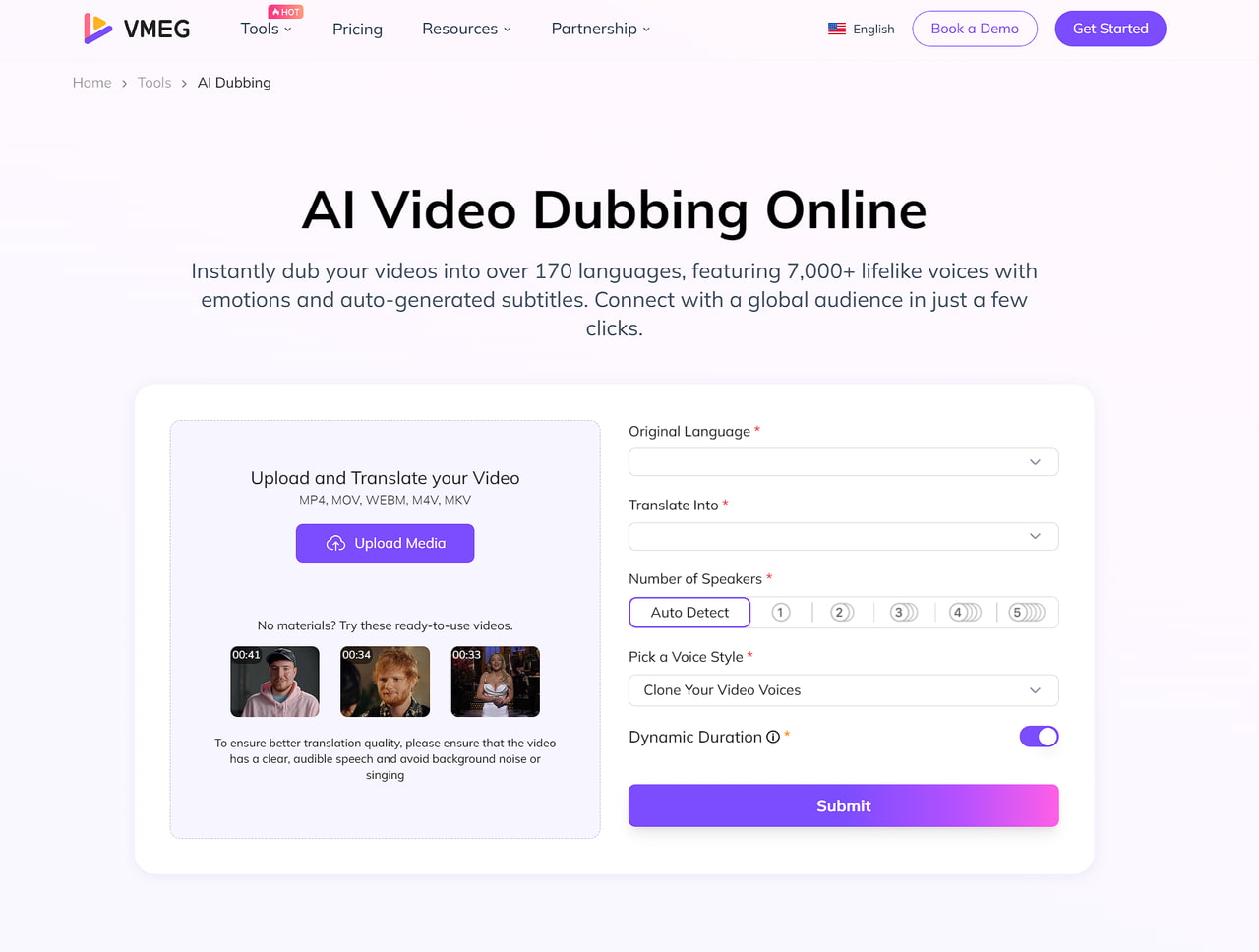
VMEG AI
VMEG AI is a video localization platform powered by AI, designed to revolutionize cross-linguistic communication with support for 170+ languages and 7,000+ voices. A collection of tools for voice cloning, dubbing, and video translation is provided by VMEG, which was created to remove language barriers and make material available to a worldwide audience. VMEG makes the difficult work of video localization simple and accurate, regardless of whether you're a multinational organization or a content producer.

Key features of VMEG:
- AI Voice Cloning: Clone your own voice for multilingual output.
- Lip-Sync Matching: AI aligns dubbed speech with mouth movements.
- Speaker Diarization: Detects multiple speakers in a single video.
- Subtitle Generation: Auto-generate captions in target languages.
Pros
- Extremely wide language and voice coverage: 170+ languages, 7,000+ voices.
- Intuitive web UI and direct imports from cloud platforms.
- No downloads; edit and preview online.
Cons
- Requires an internet connection to use.
Rask AI
Rask focuses on accurate lip-sync and is geared toward creators and studios working with long videos (their site notes support for longer uploads). It emphasizes translation fidelity, speaker control, voice cloning and collaborative/team features.

Key Features:
- Ensures natural synchronization between dubbed audio and on-screen speakers.
- Handles lengthy uploads suitable for documentaries, films, and educational content.
- Differentiates and dubs multiple speakers with precision.
- Replicates speaker tones for authentic multilingual delivery.
- Offers team and enterprise features for shared workflows.
Pros
- Good for longer-form content and detailed projects.
- Strong lip-sync and multi-speaker handling.
- Team and enterprise features.
Cons
- Can be pricier than hobbyist tools; free trial limitations.
- Some advanced features are behind higher tiers.
Pricing
- A free trial with limited minutes is available.
- Basic: 25 minutes for $60 each month
- Benefit: 150 per month for 100 minutes
- Business: 750 per month, which includes 500 minutes
Dubverse
Dubverse bills itself as a generative AI platform combining AI video dubbing, auto-subtitles, text-to-speech and an API for bulk/localization workflows. It’s geared to creators and small studios that want a credit/usage model and integration options.
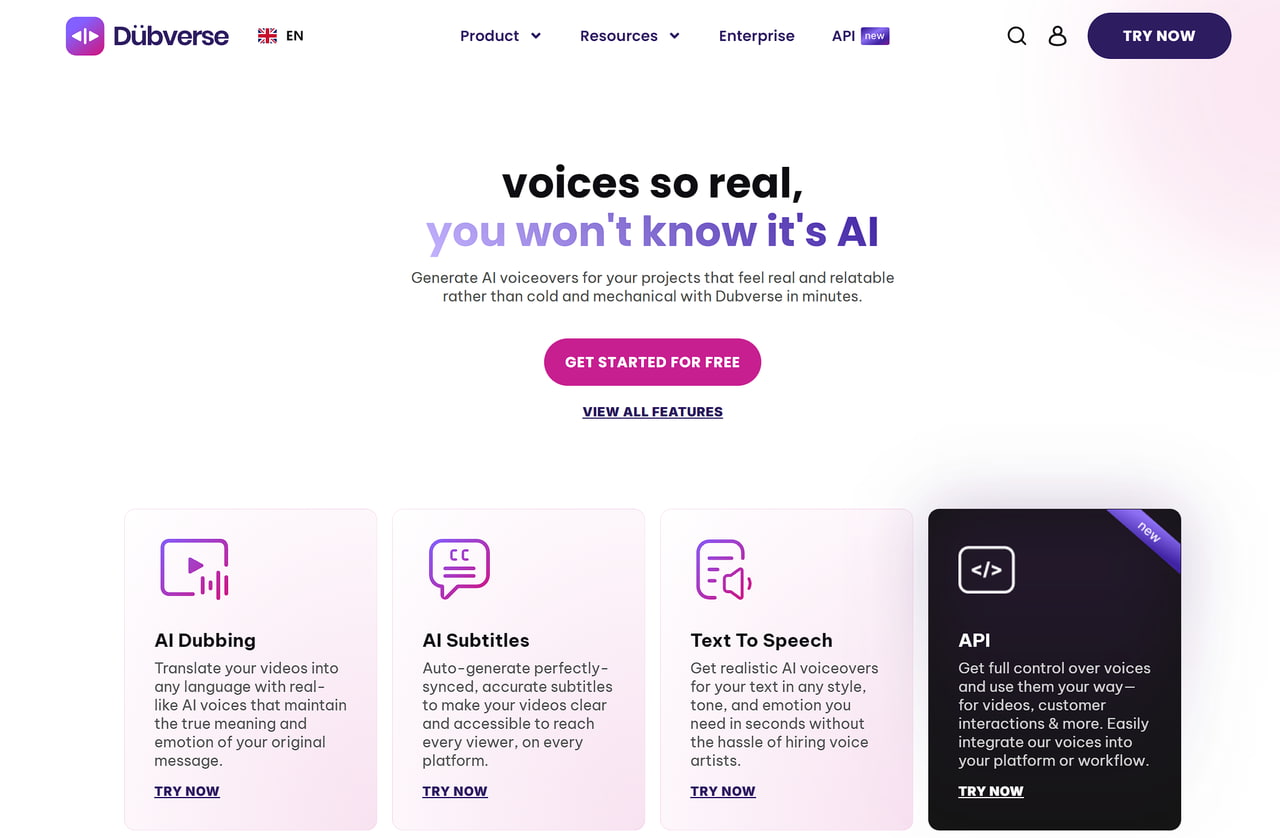
Key Features:
- Single workflow for dubbing and captioning without extra tools.
- Multiple synthetic voices for varied styles and tones.
- Enables automation and scaling for localization workflows.
- Converts scripts into natural-sounding speech.
- Credit-based, pay-as-you-go system for cost control.
Pros
- Integrated subtitle + dubbing workflow (no need to stitch multiple tools).
- API access for automation/bulk jobs.
- Pay-as-you-go credit system.
Cons
- Feature parity can vary across voice quality and languages vs. enterprise specialist vendors.
- The credits model means heavy users must estimate consumption.
Pricing
- 2-Day Free Trial available
- Pro Plan: $ 18 for 50 Credits (<60 Mins Videos)
- Supreme: $ 30 for 50 Credits (<150 Mins Videos)
- Enterprise: Need to Talk
Speechify
Speechify is widely known as a top TTS app but has expanded into an AI Dubbing/Studio product that offers high-quality voices, voice cloning and dubbing workflows suitable for creators and training content. The Studio product exposes dubbing, voiceover and batch capabilities.
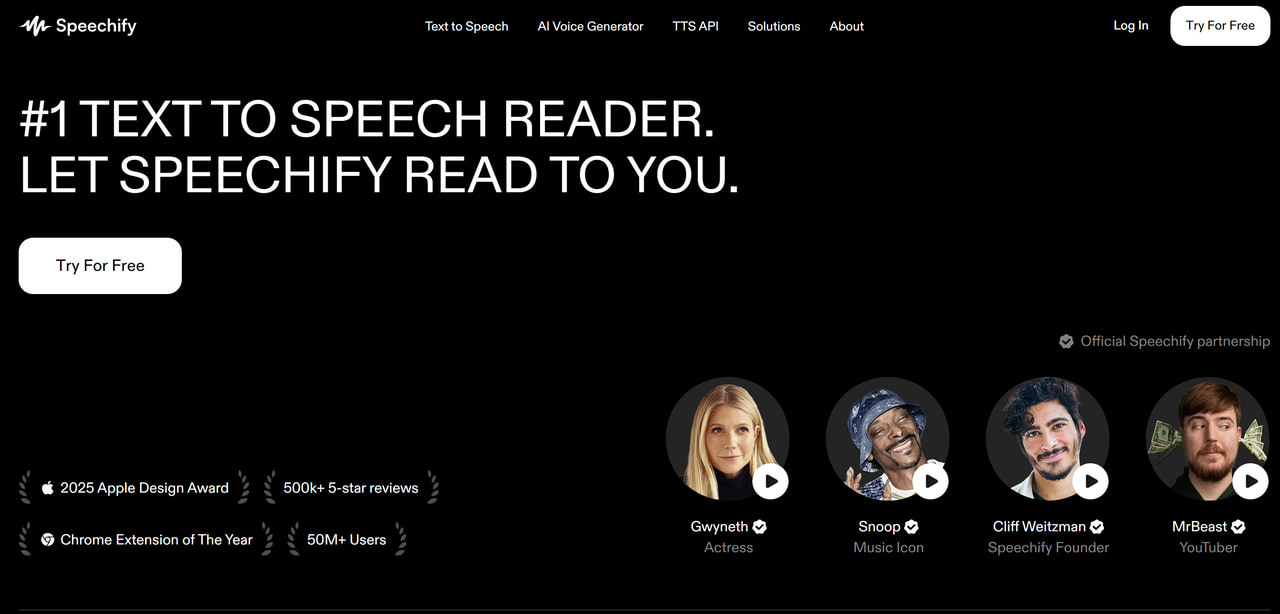
Key Features:
- Wide range of realistic, natural-sounding AI voices.
- Ability to replicate custom voices for personalized projects.
- Dedicated workspace for creating dubs and training content.
- Efficiently handle multiple files or projects at once.
- Proven text-to-speech foundation for accessibility and learning use cases.
Pros
- Large library of realistic voices; strong TTS pedigree.
- Studio options make it easy to generate voiceovers and quick dub exports.
Cons
- Primarily a TTS company — advanced lip-sync for complex multi-speaker videos may be less refined than dedicated dubbing platforms.
- Commercial licensing and higher-quality voices may require Studio/paid plan.
Pricing
- Free tier available (600 studio credits for 3 min 20s of dubbing export)
- Speechify Studio start plans: $10/month (7200 Studio credits for 40 min of dubbing export)
- Studio Creator: $30/Month (28,800 Studio credits for 3h 12m of dubbing export)
Deepdub
Deepdub focuses on media and entertainment, offering emotion-aware voice modeling and a virtual AI studio for post-production teams. It’s designed to replace or augment traditional ADR and dubbing workflows, aiming for broadcast-grade fidelity.

Key Features:
- Emotion-Aware Voice Modeling: Captures tone, emotion, and nuance for authentic performances.
- Virtual AI Studio: Tools designed for professional post-production workflows.
- Broadcast-Grade Fidelity: Suitable for film, television, and high-end media localization.
- Music & Dialogue Separation: Helps isolate and balance audio for clean dubbing.
- Enterprise Integration: Supports large-scale team workflows and studio pipelines.
Pros
- Tailored for film/TV localization and high-fidelity voice performance.
- Tools for emotion, music separation, and professional post workflows.
Cons
- Enterprise focus means pricing is custom and likely higher than creator tools.
- Small creators may find it overpowered and costly.
Maestra AI
Maestra offers a fast video dubbing service with support for over 125 languages, as well as subtitle generation and voice cloning. It’s built for creators who want seamless subtitle and dubbing workflows, along with a pay-as-you-go credit option.

Key Features:
- 125+ Languages: Wide coverage for global content.
- Subtitle + Dubbing Integration: Syncs captions and dubbed audio in one workflow.
- Voice Cloning: Allows custom voice preservation across dubs.
- Pay-as-You-Go Model: Credits-based usage suited for smaller teams.
- Cloud-Based Editor: Manage projects without installing heavy software.
Pros
- Strong subtitle tooling paired with dubbing — helpful for creators who publish both captions and dubbed audio.
- Wide language support.
Cons
- Voices and lip sync quality can vary depending on the language and voice chosen.
- Heavy localized nuance still benefits from human proofreading.
Pricing
- Starter: $49/month (120 minutes)
- Premium: $99/month (300 mins for voiceover into another language or 100 mins for pro Voices & Voice Cloning)
- Business: $199/month (600 mins for voiceover into another language or 200 mins for pro Voices & Voice Cloning)
- Business plus: $449/month (1500 mins for voiceover into another language or 500 mins ro Voices & Voice Cloning)
Vozo AI
Vozo AI focuses on accurate, multi-speaker lip-sync (Vozo LipREAL™) and voice cloning (VoiceREAL™). It targets content creators, media, and enterprise teams with tools to rewrite and dub videos while preserving speaker identity and natural sync.

Key Features:
- Advanced lip-sync for multi-speaker and interview-style videos.
- Maintains speaker identity across dubbed content.
- Handles complex dialogues naturally.
- Rewrite and dub existing clips with minimal effort.
Pros
- Good for interviews, multi-speaker videos, and complex lip movement scenarios.
- Useful suite for repurposing existing clips quickly.
Cons
- Premium features may require paid points/credits; free tier limits apply.
- Still recommended to review localized scripts for nuance.
Pricing
- Free plan with limited points.
- Premium: $19/month (100 points ~ 10 min of Lip Sync/Talking Photo/Translate & Dub)
- Business: $99/month (600points ~ 60 min of Lip Sync/Talking Photo/Translate & Dub)
BlipCut Video Translator
BlipCut is an AI dubbing and video translation tool designed for creators and agencies. It supports bulk imports, a large voice library, and offers both dubbing and voice-changing features. With a credit-based pricing model, BlipCut is particularly suited for teams managing large-scale translation and dubbing projects.

Key Features:
- Bulk Import & Export: Efficiently handle multiple videos at once.
- Voice Library: Wide range of AI voices for dubbing.
- AI Voice Changer: Customize or alter voices for different content styles.
- Flexible Pricing: Pay-as-you-go credits and bundles for scalability.
Pros
- Affordable credit bundles and pay-as-you-go options.
- Bulk translation and high minute quotas for paid plans.
Cons
- Voice realism varies by language/voice; test before large runs.
- UI/flow may be more transactional (credit spend) vs. studio edit workflows.
Pricing
- Weekly Plan: $16.99/week (30 credits)
- Monthly plan: $39.99/month (90 credits)
- Yearly plan: $299.99/year (900 credits)
- Pay-as-you-go starts low (~$0.63/credit)
HeyGen
HeyGen is best known for creating AI avatars, but it also provides AI dubbing, lip-sync, and TTS voiceovers. It’s especially useful for social media clips, marketing videos, and avatar-led content that require localized speech with natural lip movement. API integrations make it a good fit for automated workflows.
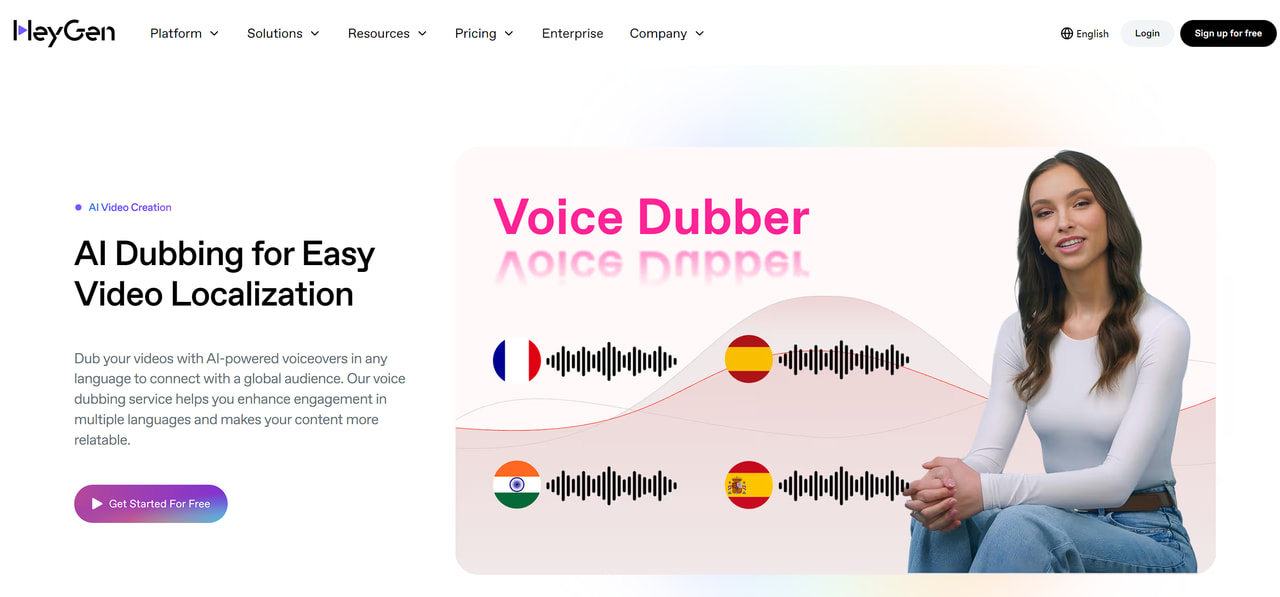
Key Features:
- AI Avatars: Human-like avatars delivering translated audio.
- Lip-Sync Dubbing: Localized voices aligned with mouth movement.
- TTS Voiceovers: Convert scripts into speech across multiple languages.
- API Access: Automate avatar and dubbing workflows at scale.
Pros
- Excellent for avatar-led content and short social videos.
- API options for automation.
Cons
- Some user reports note limits/complexities on longer video rules — always confirm plan limits. (Community feedback exists; test with a trial.)
Pricing
- Free plan: 3 Avatar IV Videos
- Creator: $29/month
- Business: $39/seat/month
Vidnoz AI
Vidnoz offers AI video translation and dubbing with lip-sync across 140+ languages, designed for marketers, educators, and small creator teams. It emphasizes ease of use and quick turnaround for social content, training materials, and promotional videos.
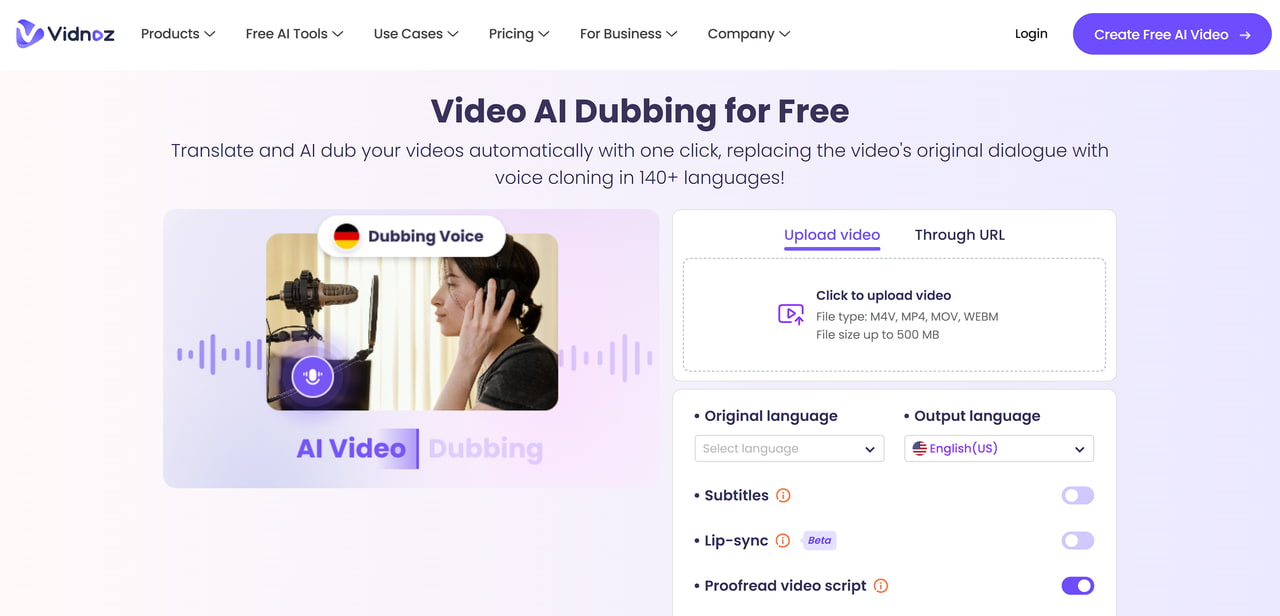
Key Features:
- 140+ Languages: Wide localization coverage.
- Lip-Sync Translation: Keeps speech aligned with the speakers.
- Team Plans: Affordable tiers for small groups and educators.
- Fast Turnaround: Simple UI for quick edits and exports.
Pros
- Generous language support and straightforward UI.
- Budget plans and educational discounts are sometimes available.
Cons
- As with similar tools, nuance and cultural localization still benefit from human review.
- Free caps can be tight for serious batch work.
Pricing
- Free tier (2 videos)
- Starter plan: $27/mo (15 Mins)
- Creator plan: $54/mo (30 Mins)
- Business plan: $540 (300 Mins)
Akool
Akool provides a suite of AI video localization tools, including free dubbing utilities, bundled into a single platform. It’s popular among creators and small teams who need accessible free options or want to prototype quickly before committing to paid solutions.

Key Features:
- Free Dubbing Tools: Entry-level utilities for experimentation.
- All-in-One Suite: Multiple video localization tools in one product.
- Rapid Prototyping: Ideal for testing creative ideas quickly.
Pros
- Helpful free tools and demos — accessible for experimentation.
- Rapid prototyping for creative testing.
Cons
- May lack enterprise SLAs, advanced quality controls and consistent voice realism vs premium rivals.
- Pricing and features vary; always verify commercial licensing.
Pricing
- Free: Upload video length: 5mins
- Pro: $30 (600 Credits, 15mins)
- Pro Max: $119 (2400 Credits, 30mins)
- Studio: $500 (12000 Credits, 60mins)
Dubbing AI
Dubbing AI specializes in real-time voice changing for streamers, gamers, and podcasters. Unlike traditional dubbing suites that focus on offline video localization, it emphasizes live content transformation with a large voice bank (500+ voices), meme soundboards, and low-latency audio routing for seamless performance.
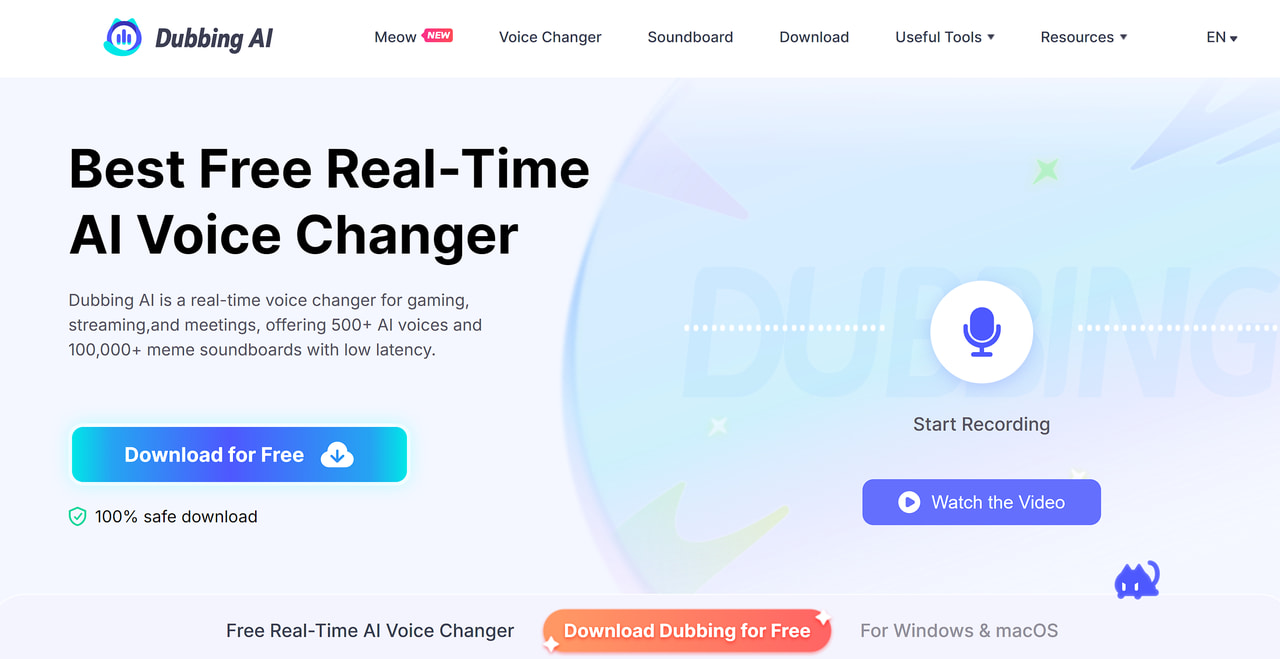
Key Features:
- Real-Time Voice Changing: Tailored for live streaming and gaming.
- 500+ Voice Bank: Wide variety of different tones and personas.
- Low-Latency Routing: Ensures smooth, synchronized audio delivery.
Pros
- Excellent for live streaming, podcasting, and on-the-fly content.
- Large voice selection and low latency.
Cons
- Not a focused offline video dubbing studio — it’s for live/real-time voice changes rather than localized video exports.
- App-specific pricing and platform compatibility to check.
Pricing
- Free app available; in-app Pro/Premium options.
Step-by-step: How to dub a video with VMEG AI
This walkthrough uses VMEG as the example because it combines translation, voice cloning and lip-sync in one web UI. The steps below transfer well to other modern dubbing tools.
Step 1. Go to the AI Video Dubbing Online section on VMEG. Upload your video file (supported formats: MP4, MOV, WEBM, M4V, MKV; up to 2 hours, 4K, 1 GB).
Step 2. Choose the target language (from 170+ available) and specify the number of speakers. Then pick a voice from VMEG’s library or clone your own voice. Optionally apply a subtitle template.
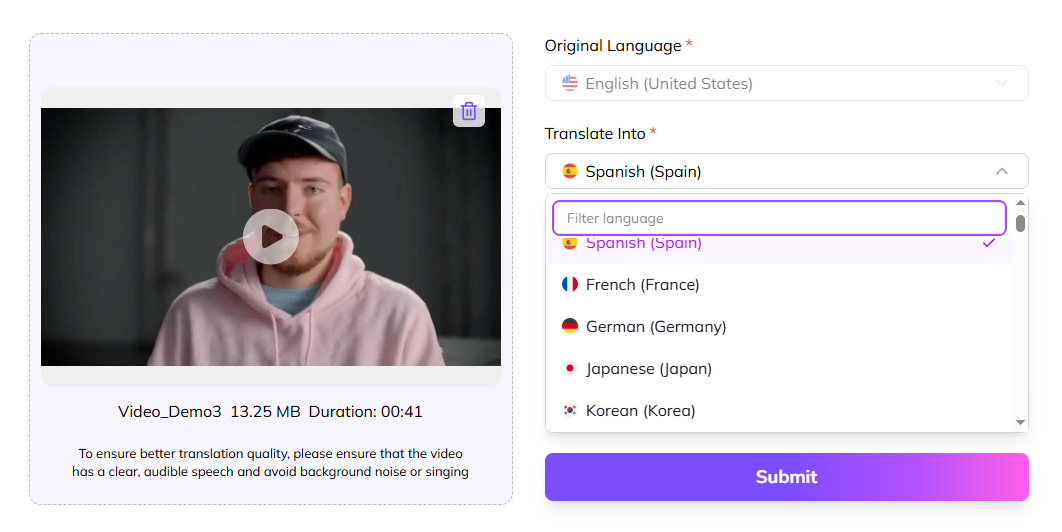
Step 3. Once processing is complete, preview the dubbed video. You can edit translated text, fine-tune voice settings (speed, pitch, tone), and adjust subtitle placement.
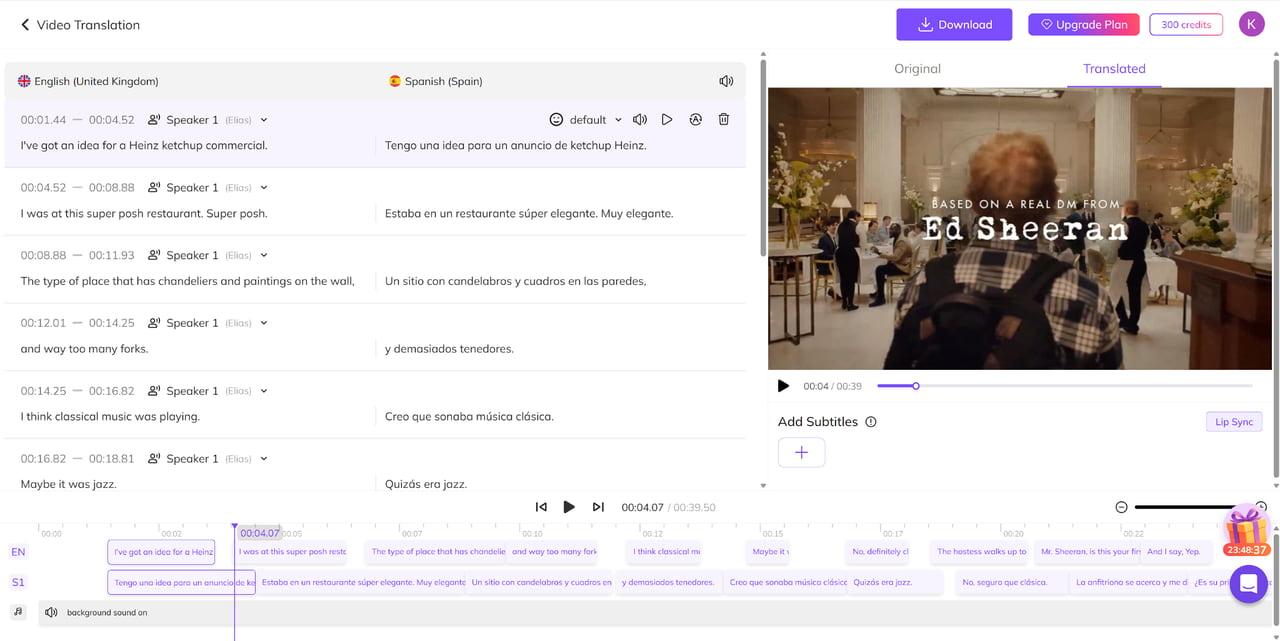
Step 4. Export Your Final Video. When satisfied, export your video and download it as an MP4 (dubbed video) or SRT (subtitle file).
FAQs AI Video & Audio Dubbing
Will AI dubbing replace human voice actors?
Not entirely. AI lowers costs and speeds up localization, but for nuanced performances, branded voices, and unionized productions, professional human actors (or hybrid human+AI workflows) remain important. High-end media still uses human oversight for tone and cultural specifics.
How accurate are lip-sync engines?
Quality varies across platforms. Tools like VMEG, Rask and Vozo emphasize lip-sync and often perform well for short to mid-length clips; longer productions may still need manual polish.
Is voice cloning legal?
Voice cloning is legal when you have consent (or a license) to clone a voice. Many platforms require consent and have usage policies; respect rights and local laws. For commercial distribution, read the platform TOS and secure releases. (Industry guidance and platform policies vary.)
Which tool is best for enterprise/large catalogs?
Enterprise buyers often prefer Deepdub, VMEG, Rask or custom enterprise offerings from major players because of SLAs, batch processing, and professional support. Contact vendors for enterprise pricing and SLAs.
How do pricing models typically work?
Common approaches: free trials/credits, pay-as-you-go credits (per minute or per character), monthly subscriptions with minute allowances, and enterprise custom quotes. Estimate your minutes and voice needs before committing.
Conclusion
In 2025, AI dubbing has become a practical tool in various fields, such as for creators, marketers, and studios to expand their reach across languages and cultures. And platforms like VMEG, Rask, or Vozo are great options for people who require quick, high-volume localization.
Captioned releases can be made more efficient with services like Maestra or Dubverse if your workflow includes both dubbing and subtitles. At the same time, business organizations looking for enterprise or broadcast-level quality will find that Deepdub and other enterprise-tier suppliers are built to satisfy those higher expectations.
Captioned releases can be made more efficient with services like Maestra or Dubverse if your workflow includes both dubbing and subtitles. At the same time, business organizations looking for enterprise or broadcast-level quality will find that Deepdub and other enterprise-tier suppliers are built to satisfy those higher expectations.
VMEG AI Video Dubbing
Translate and dub your videos into 170+ languages with 7,000+ realistic, emotion-rich voices — complete with automatically generated subtitles for global-ready content.
